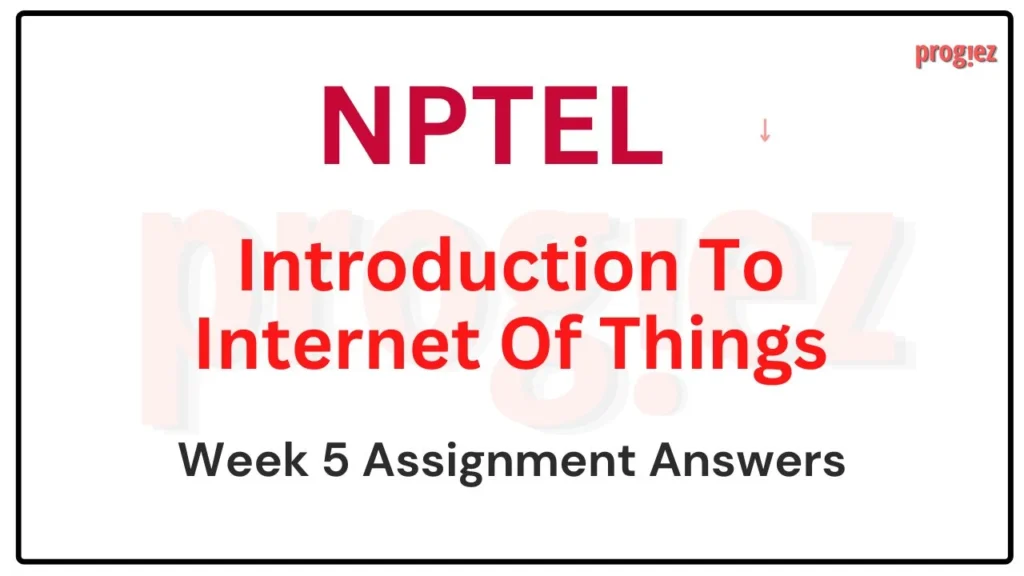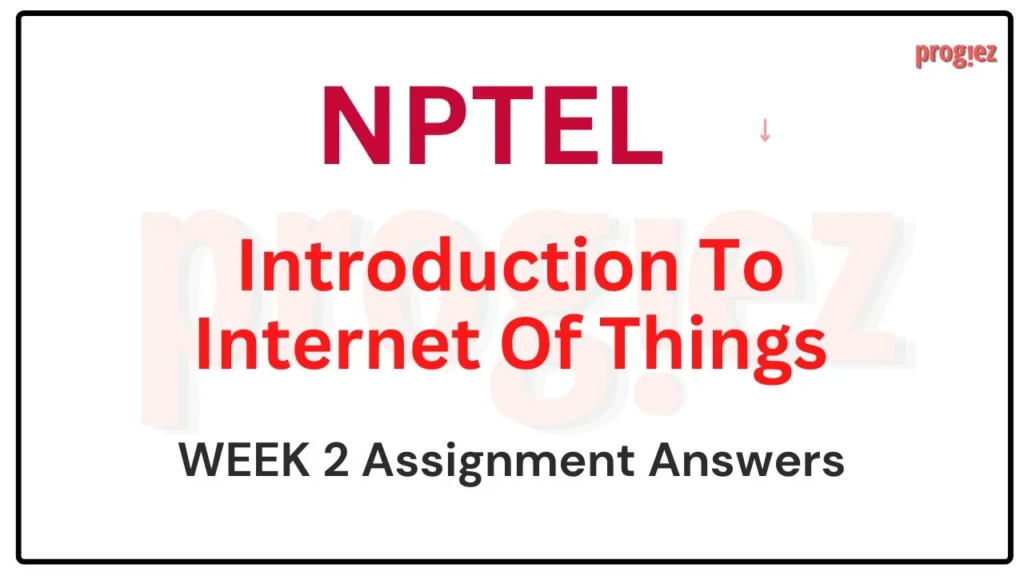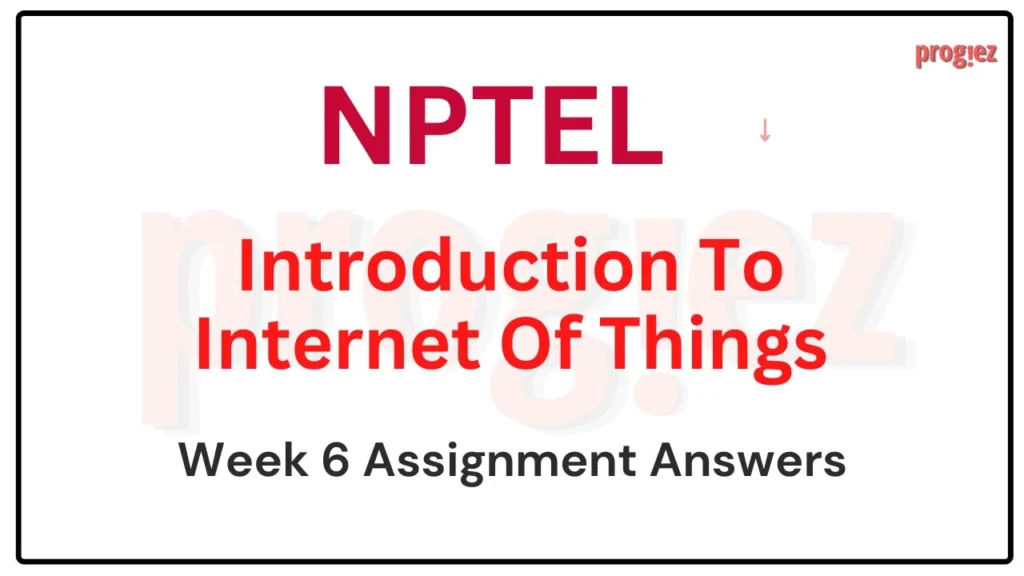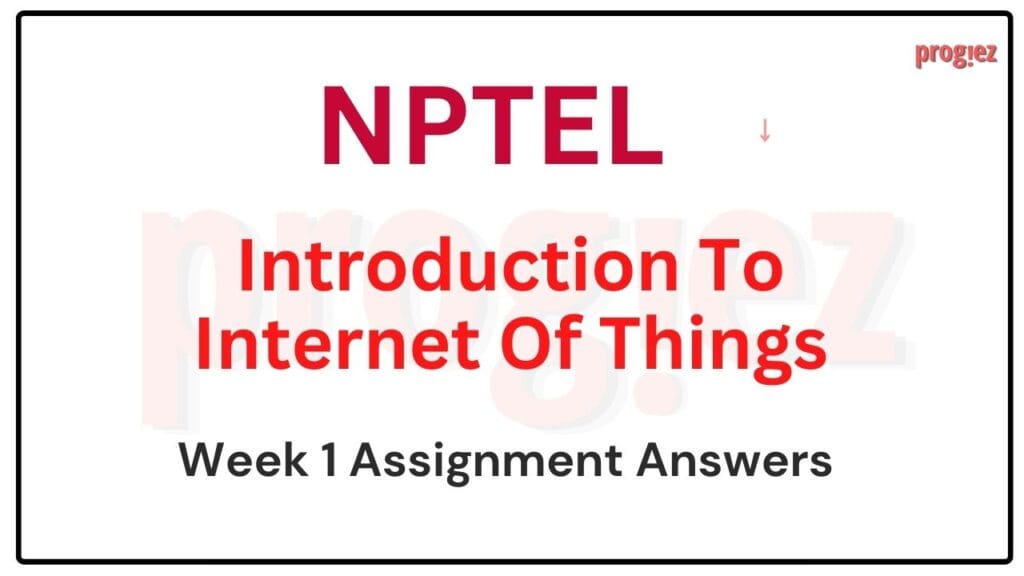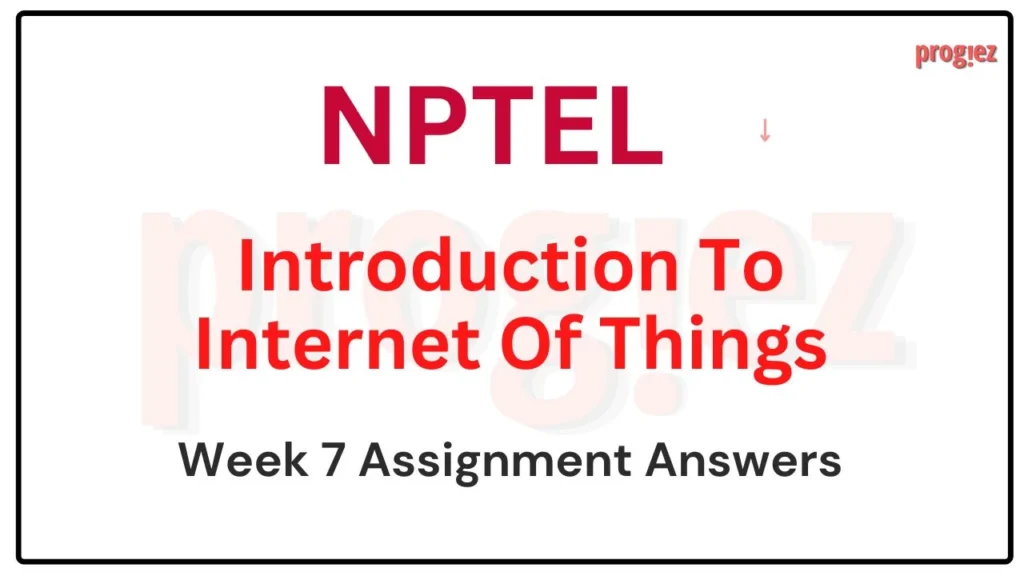Introduction To Internet Of Things Week 3 Nptel Answers
Are you searching for Introduction To Internet Of Things Week 3 Nptel Answers 2025? Look no further! Our comprehensive assignment solutions are designed to guide you through the key concepts of IoT, including networking protocols, sensor technologies, and data communication.
Course Link: Click Here
Table of Contents
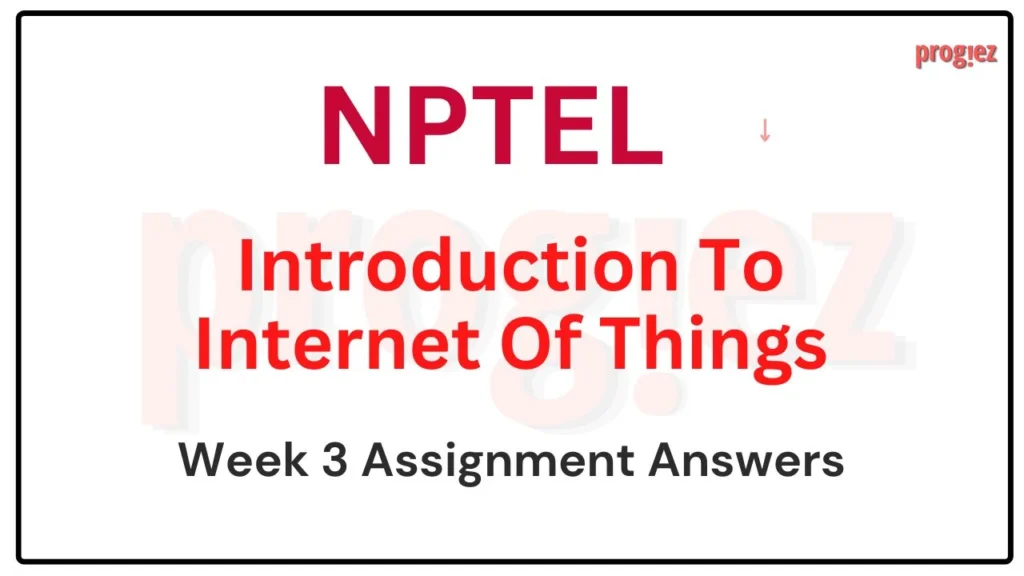
Introduction To Internet Of Things Week 3 Nptel Answers (Jan-Apr 2025)
- State True or False – “WirelessHART is the latest release of Highway Addressable Remote Transducer protocol.”
a. True
b. False
Answer: A
- State True or False – “Wired HART has a network layer.”
a. True
b. False
Answer: B
- State True or False – “WirelessHART physical layer is derived from 802.15.2 protocol.”
a. False
b. True
Answer: A
- WirelessHART operates only in: _______GHz ISM band.
a. 3.7
b. 4.8
c. 4.8
d. 2.4
- HART standard was developed from:
a. Amplified
b. Diminished
c. Isolated
d. Networked smart field devices
- Main difference between wired and unwired versions is in the physical, data link, and:
a. Data link
b. Network
c. Transport
d. None of these
- State True or False – “Collision-free and deterministic communication is achieved in HART’s data link layer.”
a. True
b. False
- Channel hopping is incorporated in which layer of HART?
a. Data link layer
b. Physical layer
c. Application layer
d. Transport layer
- State True or False – “The HART application layer is responsible for extracting commands from a message, executing it, and generating responses.”
a. True
b. False
- NFC is designed for use by devices within_______to each other.
a. Anywhere on the globe
b. A small building
c. Both (a) and (b)
d. None of these
- Passive NFC devices_____________ information which is _____________ by other devices.
a. Contain, read
b. Read, contain
c. Contain, contain
d. None of these
- State True or False – “NFC devices work on the principle of magnetic induction.”
a. True
b. False
- Bluetooth technology is based on___________.
a. HART
b. ZigBee
c. All of these
d. None of these
- State True or False – “The Link Manager Protocol in Bluetooth manages only establishment and authentication.”
a. True
b. False
- Zigbee commonly uses which data rate?
a. 260 bps
b. 260 kbps
c. 260 Mbps
d. None of these
Introduction To Internet Of Things Week 3 Nptel Answers (July-Dec 2024)
Q1.State True or False.
Statement: “Wireless HART is the latest release of Highway Addressable Remote Transducer protocol.”
a. True
b. False
Answer: a. True
Q2.State True or False.
Statement: “Wired HART does not have a network layer.”
a. True
b. False
Answer: a. True
For answers or latest updates join our telegram channel: Click here to join
These are Nptel IoT Week 3 Assignment Answers
Q3.Wireless HART physical layer is derived from protocol?
a. 802.15.4
b. 802.15.2
с. 802.15.3
d. 802.15.6
Answer: a. 802.15.4
Q4.Wireless HART operates only in GHz ISM band.
a. 3.7
b. 4.8
c. 4.8
d. None of these
Answer: d. None of these
For answers or latest updates join our telegram channel: Click here to join
These are Nptel IoT Week 3 Assignment Answers
Q5.Wireless HART employs and exploits reliability. channels of the ISM band to increase
a. 13
b. 4
с. 2
d. None of these
Answer: d. None of these
Q6,State True or False.
Statement: “Channel blacklisting identifies channels consistently affected by interference and adds them from use again.”
a. True
b. False
Answer: b. False
For answers or latest updates join our telegram channel: Click here to join
These are Nptel IoT Week 3 Assignment Answers
Q7.The Wireless HART incorporates reliability and security of the network. and to increase the
a. Channel hopping and Channel Blacklisting
b. Channel Aggregating and Frequency Aggregating
c. Both (a) and (b)
d. Neither (a) nor (b)
Answer: a. Channel hopping and Channel Blacklisting
Q8.State whether the following statement is True or False
Statement: “Wireless HART protocol relies on Mesh Networking for its communication, and each device is primed to forward packets from every other device.”.
a. True
b. False
Answer: a. True
For answers or latest updates join our telegram channel: Click here to join
These are Nptel IoT Week 3 Assignment Answers
Q9.State True or False.
Statement: “ZigBee protocol does not feature channel hopping at all.”
a. True
b. False
Answer: a. True
Q10.NFC is designed for use by devices within to each other.
a. Close proximity
b. Anywhere on the globe
с. A small building
d. None of these
Answer: a. Close proximity
For answers or latest updates join our telegram channel: Click here to join
Nptel IoT Week 3 Assignment Answers
Q11.NFC are of types?
a. 2
b. 3
с. 1
d. None of these
Answer: a. 2
Q12.State True or False.
Statement: “Smartphones are an example of active NFC devices.”
a. True
b. False
Answer: a. True
For answers or latest updates join our telegram channel: Click here to join
These are Nptel IoT Week 3 Assignment Answers
Q13 .Bluetooth technology is based on
a. HART
b. ZigBee
с. Ad-hoc piconets
d. None of these
Answer: с. Ad-hoc piconets
Q14,State whether the following statement is true or false.
Statement: The Link Manager Protocol in Bluetooth manages the establishment, authentication, link configuration.
a. True
b. False
Answer: a. True
For answers or latest updates join our telegram channel: Click here to join
These are Introduction To Internet Of Things Week 3 Nptel Answers
Q15.Zigbee commonly uses
data rate.
a. 250 Mbps
b. 260 kbps
c. 260 Mbps
d. None of these
Answer: d. None of these
For answers or latest updates join our telegram channel: Click here to join
These are Introduction To Internet Of Things Week 3 Nptel Answers
More Weeks of Introduction To Internet Of Things: Click here
More Nptel Courses: https://progiez.com/nptel-assignment-answers
Introduction To Internet Of Things Week 3 Nptel Answers (Jan-Apr 2024)
Course Name: Introduction To Internet Of Things
Course Link: Click Here
For answers or latest updates join our telegram channel: Click here to join
These are Introduction To Internet Of Things Week 3 Assignment 3 Answers
Q1. State whether the following statement is true or false.
Statement: There is no network layer in Wired HART
a. True
b. False
Answer: a. True
Q2. HART operates only in ________ GHz ISM band.
a. 2.4
b. 4.8
c. 4.9
d. 4.4
Answer: a. 2.4
Q3. Super-frames in HART consist of grouped _______ wide timeslots.
a. 10ms
b. 20ms
c. 55ms
d. None of these
Answer: a. 10ms
For answers or latest updates join our telegram channel: Click here to join
These are Nptel Introduction To Internet Of Things Week 3 Assignment Answers
Q4. The process of identifying channels consistently affected by interference and removing them from use is known as _________.
a. Channel hopping
b. Channel aggregating
c. Frequency aggregating
d. Channel blacklisting
Answer: d. Channel blacklisting
Q5. State whether the following statement is True or False
Statement: Each node is supervised by the application manager and it guides them on when and where to send packets.
a. True
b. False
Answer: b. False
Q6. FeliCa is commonly found in which country?
a. Japan
b. India
c. USA
d. None of these
Answer: a. Japan
For answers or latest updates join our telegram channel: Click here to join
These are Nptel Introduction To Internet Of Things Week 3 Assignment Answers
Q7. State whether the following state is true or false.
Statement: NFC tags found in supermarket products are examples of passive NFC.
a. True
b. False
Answer: a. True
Q8. Active NFC devices are able to _____________?
a. transmit information
b. collect information
c. Both (a) and (b)
d. None of these
Answer: c. Both (a) and (b)
Q9. A_________ in NFC emits a small electric current which creates a magnetic field that in turn bridges the physical space between the devices.
a. reader
b. writer
c. destroyer
d. None of these
Answer: a. reader
For answers or latest updates join our telegram channel: Click here to join
These are Nptel Introduction To Internet Of Things Week 3 Assignment Answers
Q10. Bluetooth technology is based on ____________.
a. WiFi
b. LoRa
c. Ad-hoc technology
d. None of these
Answer: c. Ad-hoc technology
Q11. Bluetooth technology operates in the unlicensed industrial, scientific and medical (ISM) band at _______ to ________ GHz.
a. 3.2, 5.6
b. 2.4, 2.485
c. 5.0, 5.89
d. None of these
Answer: b. 2.4, 2.485
Q12. Z-wave operates at ________ MHz in the US and ________ MHz in Europe.
a. 1008, 989
b. 908.42, 868.42
c. 767.56, 855.28
d. None of these
Answer: b. 908.42, 868.42
For answers or latest updates join our telegram channel: Click here to join
These are Nptel Introduction To Internet Of Things Week 3 Assignment Answers
Q13. State whether the following statement is true or false.
Statement: Sensor nodes have limited battery life.
a. True
b. False
Answer: a. True
Q14. State whether the following statement is true or false.
Statement: The Link Manager Protocol in Bluetooth manages the establishment, authentication, link configuration.
a. True
b. False
Answer: a. True
Q15. Zigbee commonly uses _________ data rate.
a. 250 kbps
b. 250 Mbps
c. 260 kbps
d. 260 Mbps
Answer: a. 250 kbps
For answers or latest updates join our telegram channel: Click here to join
These are Nptel Introduction To Internet Of Things Week 3 Assignment Answers
More Weeks of Introduction To Internet Of Things: Click here
More Nptel Courses: Click here
Introduction To Internet Of Things Week 3 Nptel Answers (July-Dec 2023)
Course Name: Introduction To Internet Of Things
Course Link: Click Here
These are Nptel Introduction To Internet Of Things Week 3 Assignment Answers
Q1. State whether the following statement is true or false.
Statement: Wired HART lacks a network layer.
a. True
b. False
Answer: a. True
Q2. The HART physical layer is derived from _ protocol and operates only in ___ GHz ISM band.
a. IEEE 802.15.4, 2.4
b. IEEE 802.15.4, 4.8
c. IEEE 802.16.5, 4.8
d. None of these
Answer: a. IEEE 802.15.4, 2.4
Q3. State whether the following statement is True or False
Statement: Super-frames in HART consist of grouped 20ms wide timeslots.
a. True
b. False
Answer: b. False
These are Nptel Introduction To Internet Of Things Week 3 Assignment Answers
Q4. _____ identifies channels consistently affected by interference and removes them from use.
a. Channel hopping
b. Channel aggregating
c. Channel blacklisting
d. Frequency aggregating
Answer: c. Channel blacklisting
Q5. The _____ supervises each node in the network and guides them on when and where to send packets.
a. Application manager
b. Network manager
c. Trust manager
d. None of these
Answer: b. Network manager
Q6. NFC is designed for use by devices within _ to each other?
a. Close proximity
b. No near contact
c. Both (a) and (b)
d. None of these
Answer: a. Close proximity
These are Nptel Introduction To Internet Of Things Week 3 Assignment Answers
Q7. __ contain information which is readable by other devices, however it cannot read information itself.
a. Active NFC devices
b. Dumb NFC devices
c. Passive NFC devices
d. None of these
Answer: c. Passive NFC devices
Q8. NFC devices work on the principle of _______?
a. Magnetic introduction
b. Magnetic induction
c. Both (a) and (b)
d. None of these
Answer: b. Magnetic induction
Q9. Which of these is NOT a mode of operation NFC?
a. Server-to-Server
b. Peer-to-Peer
c. Read/Write
d. Card emulation
Answer: a. Server-to-Server
These are Nptel Introduction To Internet Of Things Week 3 Assignment Answers
Q10. State whether the following statement is true or false
Statement: Paging in Bluetooth is the process of forming a connection between two Bluetooth devices.
a. True
b. False
Answer: a. True
Q11. There are __ modes of operation in Bluetooth.
a. 3
b. 4
c. 5
d. None of these
Answer: b. 4
Q12. Zwave uses __ for signaling and control?
a. Light
b. RF
c. Sound
d. None of these
Answer: b. RF
These are Nptel Introduction To Internet Of Things Week 3 Assignment Answers
Q13. Which of the following is/are not a constraint on sensor nodes?
a. Must consume high power
b. Not be adaptive to the environment
c. Both (a) and (b)
d. None of these
Answer: c. Both (a) and (b)
Q14. _ are simply those that are unable to perform an operation; this could be because of power failure and environmental events.
a. Normal nodes
b. Failed nodes
c. Badly failed nodes
d. None of these
Answer: b. Failed nodes
Q15. Dumb behavior of sensor nodes is ___ in nature (as it is dependent on the effects of the environmental conditions).
a. Temporal
b. Spatial
c. Both (a) and (b)
d. None of these
Answer: a. Temporal
These are Nptel Introduction To Internet Of Things Week 3 Assignment Answers
More Weeks of Introduction To Internet Of Things: Click here
More Nptel Courses: Click here
Introduction To Internet Of Things Week 3 Nptel Answers (Jan-Apr 2023)
Course Name: Introduction To Internet Of Things
Course Link: Click Here
These are Nptel Introduction To Internet Of Things Week 3 Assignment Answers
Q1. Choose the correct option based on the following two statements on the HART Physical Layer.
Statement-I : It is derived from the IEEE 802.15.4 protocol.
Statement-II : It operated only in the 2.4 GHz ISM band.
a. Statement-I True and Statement-II False
b. Statement-I False and Statement-II True
c. Both Statements I and II are False
d. Both Statements I and II are True
Answer: d. Both Statements I and II are True
Q2. Which of the following characteristic of HART Data Link Layer helps to increase reliability and security?
a. Channel Hopping and Channel Blacklisting
b. Channel Crunching and Jamming
c. Scattering
d. All of these
Answer: a. Channel Hopping and Channel Blacklisting
Q3. State True or False
Statement : Channel blacklisting in HART identifies channels consistently affected by interference and removes them from use.
a. True
b. False
Answer: a. True
These are Nptel Introduction To Internet Of Things Week 3 Assignment Answers
Q4. At the MAC layer –
Statement-I : WirelessHART utilizes Time Division Multiple Access (TDMA).
Statement-II : ZigBee applies Carrier Sense Multiple Access with Collision Detection (CSMA/CD).
a. Statement-I True and Statement-II False
b. Statement-I False and Statement-II True
c. Both Statements I and II are False
d. Both Statements I and II are True
Answer: a. Statement-I True and Statement-II False
Q5. NFC works on the principal of
a. Pressure
b. Magnetic Induction
c. Both (a) and (b)
d. None of these
Answer: b. Magnetic Induction
Q6. Bluetooth technology is based on Ad-hoc technology also known as?
a. Ad-hoc Piconets
b. Ad-hoc Micronets
c. Ad-hoc Nanonets
d. None of these
Answer: a. Ad-hoc Piconets
These are Nptel Introduction To Internet Of Things Week 3 Assignment Answers
Q7. Class 2 Bluetooth radios have a range of about?
a. 1 m
b. 2 m – 5 m
c. 10m
d. None of these
Answer: c. 10m
Q8. Which of the following is NOT a phase in Bluetooth connection establishment?
a. Inquiry
b. Booking
c. Paging
d. Connection
Answer: b. Booking
Q9. Zwave can support ________ number of nodes in a network?
a. 232
b. 233
c. 234
d. 235
Answer: a. 232
These are Nptel Introduction To Internet Of Things Week 3 Assignment Answers
Q10. Topologies allowed in ISA 100.11A are?
a. Ring Only
b. Mesh and Hybrid
c. Mesh and Ring
d. Mesh and Star/Tree
Answer: d. Mesh and Star/Tree
Q11. An example of an Operating System (OS) that a sensor node can have is?
a. MicronOS
b. TinyoOS
c. Both (a) and (b)
d. None of these
Answer: b. TinyoOS
Q12. Which of the following is NOT a constraint on sensor nodes?
a. Must consume extremely low power
b. Be non-autonomous
c. Be adaptive to environment
d. None of these
Answer: b. Be non-autonomous
These are Nptel Introduction To Internet Of Things Week 3 Assignment Answers
Q13. Nodes in WSNs that exhibit features of failed nodes but they can also send false routing messages which are a threat to the integrity of the network are called?
a. Normal Nodes
b. Badly Failed Nodes
c. Failed Nodes
d. Selfish Nodes
Answer: b. Badly Failed Nodes
Q14. Which of the following are the two popular schemes to re-establish the connectivity between dumb nodes with others?
a. COARD and CORD
b. CoRAD and COARD
c. CORD and CORAD
d. None of these
Answer: c. CORD and CORAD
Q15. Full form of WBAN is?
a. Wireless Body Area Network
b. Wirelessed Body Area Network
c. Wireless Bodily Area Network
d. None of these
Answer: a. Wireless Body Area Network
These are Nptel Introduction To Internet Of Things Week 3 Assignment Answers
All weeks of Introduction to Internet of Things: Click Here
More Nptel courses: Click Here
Introduction To Internet Of Things Week 3 Nptel Answers (Jul-Dec 2022)
These are Nptel Introduction To Internet Of Things Week 3 Assignment Answers
Course Name: Introduction To Internet Of Things
Link to Enroll: Click Here
Q1. Which of the following handles packets, paging and inquiry in Bluetooth?
a. L2CAP
b. Baseband
c. RFComm
d. Physical Radio
Answer: b. Baseband
Q2. Which of the following incorporates channel hopping after every packet transmission?
a. Zigbee
b. WirelessHART
c. 6LoWPAN
d. None of these
Answer: b. WirelessHART
Q3. In “X protocol, a central network controller device sets-up a network with 1 Network ID and multiple node IDs for the devices in it. The nodes with different Network IDs cannot communicate with each other. What is “X*”2
a. Z-wave
b. Zigbee
c. Bluetooth
d. ISA 100.11A
Answer: a. Z-wave
These are Nptel Introduction To Internet Of Things Week 3 Assignment Answers
Q4. In the context of Sensor Web, SensorML stands for
a. Sensor Modeling language
b. Sensor Machine language
c. Sensor Markup language
d. None of the above
Answer: a. Sensor Modeling language
Q5. Which of the following protocol is best suited to provide interference-free communication while minimizing latency and ensuring quality of service?
a. WirelessHART
b. ISA100.11A
c. Both WirelessHART and ISA100.11A
d. None of these
Answer: d. None of these
Q6. Which of the following solution approach is used to overcome the limitation of ineffective wakeup and sensing under rare event monitoring scenario in social sensing?
a. Duty-cycle management
b. Sleep-cycle management
c. Packet transmission management
d. Both duty-cycle and sleep-cycle management
Answer: a. Duty-cycle management
These are Nptel Introduction To Internet Of Things Week 3 Assignment Answers
Q7. Which of the following technique Bluetooth master uses to avoid collisions during transmission in a Piconet?
a. Frequeney Division Multiplexing d Ou
b. Frequency Hopping Spread Spectrum
c. Time Division Multiplexing
d. Direct Sequence Spread Spectrum
Answer: c. Time Division Multiplexing
Q8. Which of the following limitation is faced by total co-operation in Wireless Ad Hoc and Sensor Networks?
a. Decreasing network throughput
b. Decreasing energy
c. Both (a) and (b)
d. No limitation exists
Answer: c. Both (a) and (b)
Q9. Which of the following can function over a reliable packet transfer protocol?
a. L2CAP
b. Service Discovery Protocol
c. RFComm
d. Physical Radio
Answer: b. Service Discovery Protocol
These are Nptel Introduction To Internet Of Things Week 3 Assignment Answers
Q10. In which of the following mode, NFC devices can act as both readers as well as tags?
a. Reader/writer
b. P2P
c. Emulation
d. NFC devices can’t act as both readers as well as tags
Answer: b. P2P
Q11. In WSN, Information theoretic self-management (INTSEM) controls the transmission rate of a node by adjusting a node’s
a. Duty cycle
b. Lifetime
c. Sleep time
d. Can’t control the transmission rate
Answer: c. Sleep time
Q12. Which of the following layer of ISA 100.11A supports mesh routing?
a. Netwok layer
b. Data link layer
c. Transport layer
d. MAC layer
Answer: b. Data link layer
These are Nptel Introduction To Internet Of Things Week 3 Assignment Answers
Q13. Which of the following is used to avoid interference-prone channels in HART?
a. Channel blacklisting
b. Channel switching
c. Channel hopping
d. Super-trames
Answer: b. Channel switching
These are Nptel Introduction To Internet Of Things Week 3 Assignment Answers
Q14. When the devices are not in range, messages are routed through different nodes to bypass obstructions created by household appliances or layouts. Which of the following exhibit such characteristic of avoiding radio dead-spots?
a. Bluetooth
b. 6LoWPAN
c. Z-wave
d. Zigbee
Answer: c. Z-wave
These are Nptel Introduction To Internet Of Things Week 3 Assignment Answers
Q15. Which of the following is TRUE in tems of power (in mW) and range (in m) of the classes of Bluetooth devices?
a. Class-1: Power=100mW, Range=100m
b. Class-2: Power=2.5 mW, Range=100m
c. Class-1: Power=2.5 mW, Range=100m
d. Class-2: Power=100 mW, Range=100m
Answer: a. Class-1: Power=100mW, Range=100m
These are Nptel Introduction To Internet Of Things Week 3 Assignment Answers
